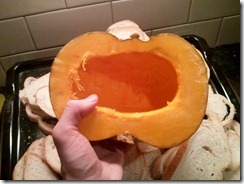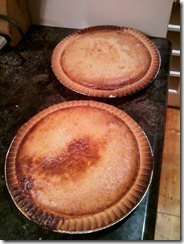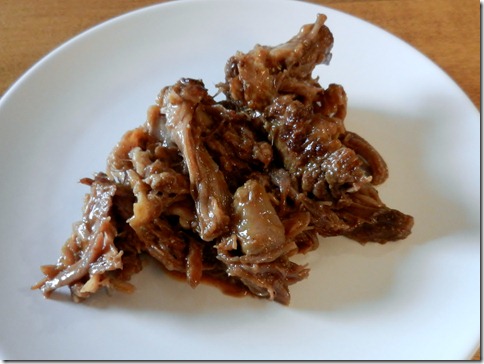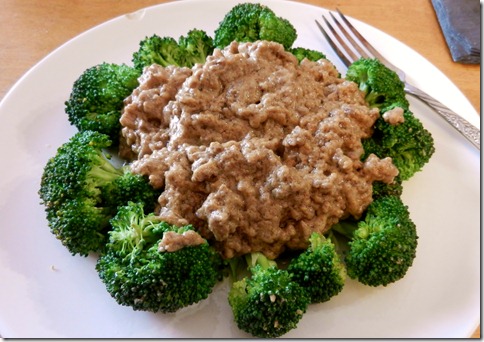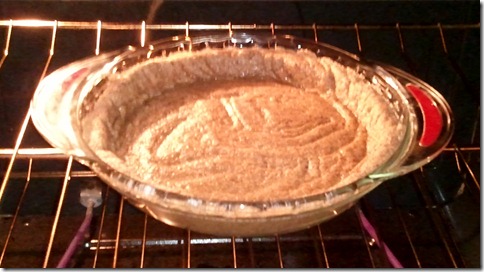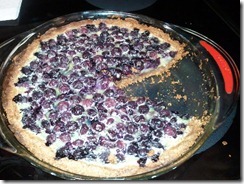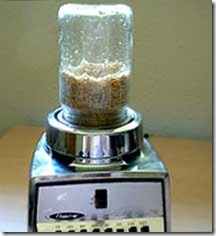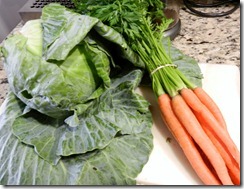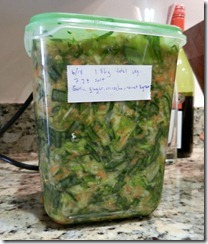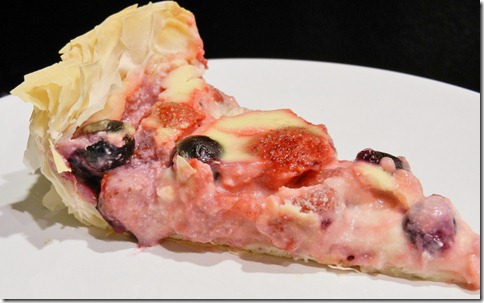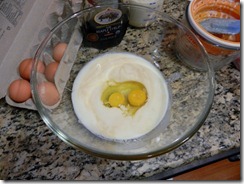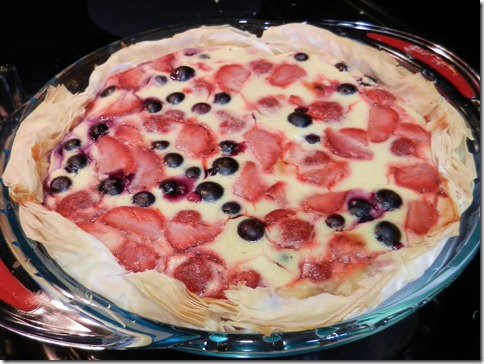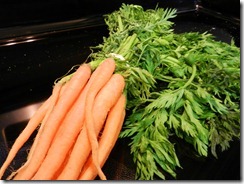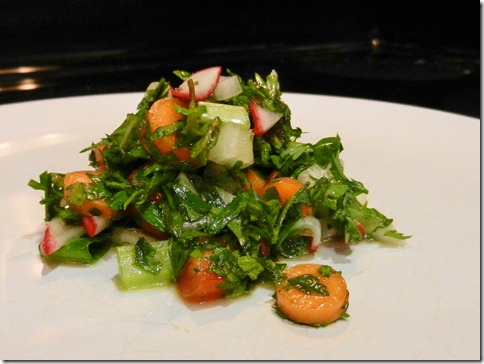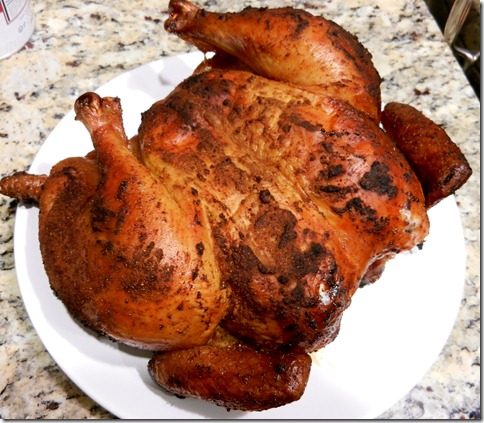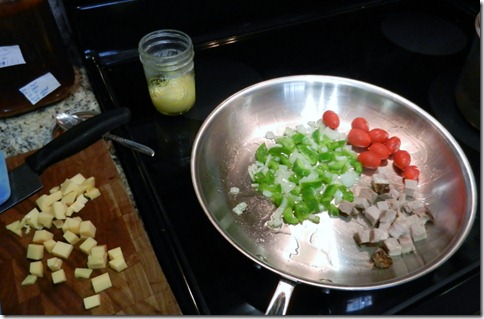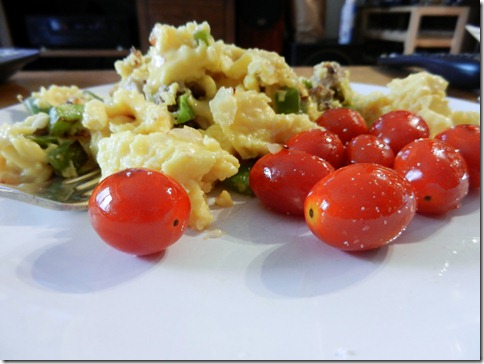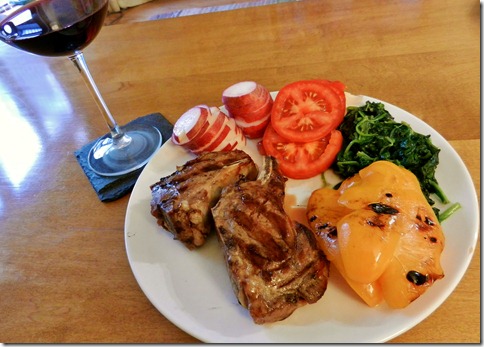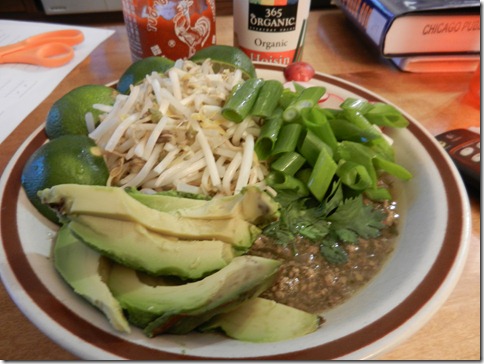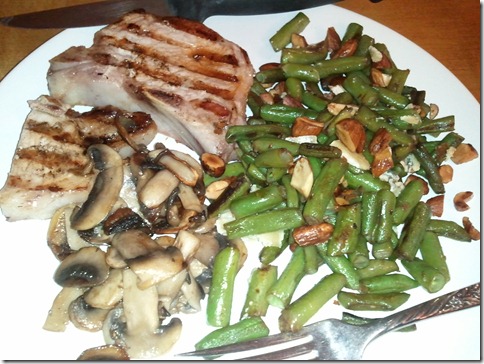Eat local, eat seasonal, eat grass fed, eat healthy animals, eat primal, eat food without labels, and get some exercise.
Monday, December 19, 2011
Post Workout Meal
Saturday, November 26, 2011
Prawn Kebabs
This appetizer is a crowd pleaser—shrimp on the barbie with tons of flavor and nice kick of heat.
Soak a handful of wood skewers in water.
- 1T Garam masala
- 1/2t cayenne pepper (to taste)
- 1T pressed garlic (~3 cloves)
- 1T minced ginger (~1 inch)*
- 1t salt
- A few T olive oil (enough for the above to have a light paste consistency
- 1kg/2lbs fresh prawns, peeled, tail-on, deveined and butterflied**
*Use a spoon to peel ginger, it works marvelously.
**Butterflying just creates more surface area for the marinade to get into.
Mix everything, let marinate for 2 hours in refrigerator. Put onto skewers and throw on a hot BBQ. Cook for 2 to 4 minutes per side..
Garnish with minced cilantro/coriander leaves and fresh lime juice. Serve hot.
Betty Coe's Thanksgiving Dressing
This recipe comes from my grandma, Betty Coe.
2 large loaves of good white bread, sliced. Lay out on platters or trays for 2-3 days to dry. Cut into squares.
2 onions (2 1/2 -3” in diameter) chopped.
8 ribs of celery, chopped.
Sauté onion and celery in 2 sticks of butter (may sauté the day before & refrigerate overnight).
3 eggs, beaten.
Add to taste:
3 Tablespoons ground sage
3/4 - 1 Tablespoon salt
1/2 teaspoon pepper
Mix in the celery/onion/butter with eggs/bread/spices. Add turkey stock until bread is moist but not soggy (at least a cup; you have to go by consistency says my mom).
Bake uncovered in two pans, 9x13" and a smaller one. 350ºF/175ºC conventional / 120ºC forced fan for 45 minutes to 1 hour.
Notes for next time: I used a very delicious white sourdough from the market. The loaves were bigger than a store-bought loaf, and I should have used 50% less bread. I used a rushed stock that didn't have much flavor…I can do much better than that.
Pumpkin Pie…Made from a Pumpkin
This Thanksgiving I'm out of the States*, and canned pumpkin isn't available. What's a guy to do? Roast a pumpkin, of course.
I found a Sweet Grey pumpkin at the Market, sold as a 1kg half. Placed face-down in a baking pan (so that it steams itself with its own moisture), roasted at 180ºC in a forced fan oven for 30 or 40 minutes, until a knife easily slipped through the flesh from the outside.
Once roasted, the thin skin peeled off easily and I mashed the insides; yielded approximately 4 cups. I was concerned about the wateriness of the mash, but I shouldn't have been. I should have taken a picture of that. On to making the pie.
The Pie
I evaluated a few recipes for similarities. There seemed to be two families: evaporated milk with sugar, or sweetened condensed milk. They all agreed on eggs to make a custard filling. The final spice mix is also a source of debate. Here's where I landed. Makes 2 pies.
- 4 cups roasted pumpkin mash
- 2 cans (14oz/395g each) sweetened condensed milk
- 2 eggs**
- 2 teaspoons ground cinnamon
- 1/2 teaspoon ground nutmeg
- 1 teaspoon fresh minced ginger
- 1/4 teaspoon ground cloves
- 1 teaspoon salt
**I added two egg yolks because I had them lying around. Don't know if it mattered.
Whisk all ingredients thoroughly. Pour into two pie shells. Place into a 220ºC/425ºF conventional oven / 160ºC forced fan oven. After ten minutes lower temperature to 175ºC/350ºF conventional / 120ºC forced fan. Cook for another 30 minutes and check for doneness with a toothpick in the center. Rotate a half turn once during cooking.
Let cool on a rack for an hour or two before refrigerating.
*Cooking in ovens where convection/forced fan is common, and where they're labeled in Celsius has been a challenge. As a general rule, I reduce the temperature or time by 30% and keep a close eye it. I usually lower the temperature and keep the time as written.
Notes for next time: Is there a recipe that uses cream and not canned milk? Try this one with cream and honey.
Monday, November 21, 2011
Bringing Lunches to Work
I've recently found myself back in the corporate world, which means dealing with the uncertainties of lunch. Eating out while avoiding excess grains and starches can be challenging, so I opt to bring my lunch at least four days a week. To make things easy, I do some prep work on Sunday evening. The goal is simple: in the mornings before work, making my lunch should be as easy as grabbing handfuls of ingredients--no prep, cutting, or dirtying dishes.
To that end, the first picture shows all of my little containers of deliciousness. Clockwise from the top: lettuce, baked boneless chicken thighs (topped in seasoning & olive oil, then diced and mixed back in with its drippings), avocado, red capsicum/bell pepper, feta, marinated olives, raw onion and tomatoes. The mix varies a bit from week to week, but you get the idea.
Assemble, top with oil, and off I go to work. An hour of prep on Sunday means making a lunch takes five minutes each morning.
Sunday, August 7, 2011
Perfect Omelettes
- Work over medium heat
- Start with a hot skillet
- Add clarified butter; coat the pan evenly
- Add four whisked eggs
- Cover for a minute or so, until cooked most of the way through
- Add some fillings
- Slip a thin flipper under the eggs, fold over
- Add a splash of water, cover again to finish cooking
- Slide out. Perfect!
Discussion: Clarified butter added to a hot skillet are the keys to making perfect omelettes. Clarified butter handles high temperatures beautifully and doesn't stick. You can see in the video that the pan isn't even perfectly clean—I had just finished frying breakfast sausage in it and only scraped out the crud with a splash of hot water.
Also, cooking with one hand while filming with the other was challenging.
Music: Merry Go Kevin MacLeod (incompetech.com) Licensed under Creative Commons "Attribution 3.0"
Edited with Windows Live Movie Maker version 2011 (which was pleasant and easy to use).
Tuesday, July 26, 2011
Sauerkraut in pictures, and under 10 minutes
aut in pictures, and under 10 minutes
- Peel and discard any wilted outer leaves. Rinse the cabbage head.
- Core the cabbage. I discarded the core, but you could also include it.

- Cut it into pieces that fit in your food processor's chute.
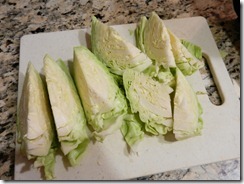
- Use the slicer blade and shred it (not the grater/shredder blade, the slicer will get it fine enough).

- Weigh it.
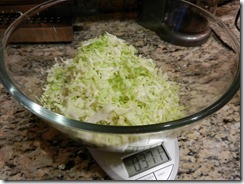
- Add 2% salt by weight. In this case I added 7 grams.
Add salt: 4 teaspoons per kilogram. In this case, I used 1.5t.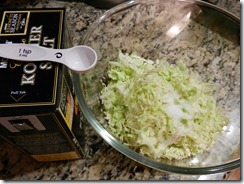
- Use your hands to smoosh it and wilt the cabbage leaves. You're trying to get it to release its own water to make a brine.
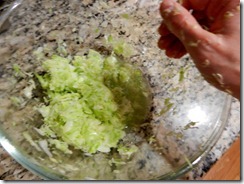
- Pack it into a jar. The cabbage should be fully submerged in the brine. If not, add a touch of water.
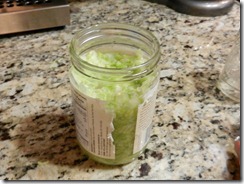
- Put
a lid on it and label it with the date. Leave it on the counter for a
few days. Check on it regularly to ensure it's still submerged in the
brine. Taste it every so often. Once it's ripe put it in the fridge to
slow ripening.
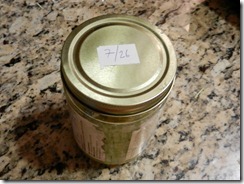
Thursday, July 21, 2011
Calories Yesterday
Worked out in the morning: deadlifts, chin ups, bent over row, crunches. I'm a 5'11" male, 166lbs, probably ~10 to 12% bodyfat. Goals are strength & muscle gain, maintain lean profile.
| Time | Description | Calories (kcal) | Fat (g) | Carbs (g) | Protein (g) |
| 1:00pm | 4 egg omelet with a chicken breast, green onions and bleu cheese, with a small sweet potato on the side. | 1138 | 60 | 43 | 105 |
| 2:30pm | Protein Shake (1 scoop w/water) | 120 | 1 | 3 | 24 |
| 3oz Cherries | 50 | 0 | 13 | 0 | |
| 5:30pm | 21oz beef sirloin tips, 4oz yogurt (marinade), 1T butter, 3oz lettuce | 1469 | 71 | 16 | 179 |
| 9:15pm | Protein Shake (1.5 scoops w/ 1/2 cup milk) | 240 | 4 | 11 | 40 |
| 15g Bleu cheese, 55g sauerkraut, 30 g cashews | 236 | 18 | 11 | 8 | |
| TOTAL | 3253 | 154 | 97 | 356 | |
| Calories from each | 1386 | 388 | 1424 | ||
| As % of Total | 43 | 12 | 44 |
Discussion. Every once in a while I keep a tally to see how I'm doing. Use a kitchen scale and WolframAlpha.com to compute your macros. It's of course an approximation, but as close as you can get, I think.
For calories from each, use 9 cal/gram for fat, and 4 cal/gram for carbs and protein. You may notice that the percentages in the last row only add up to 98%. Close enough!
Friday, July 15, 2011
Braised Veal Chuck Roast
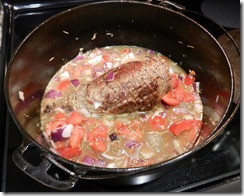 Preheat oven to 350ºF
Preheat oven to 350ºF - In Dutch oven, brown all sides of a 2lb boneless veal chuck roast in bacon fat
Add to Dutch oven:
- 4 cups homemade chicken stock
- 2T rosemary
- 1t paprika
- 1/4t cumin
- 1 cinnamon stick
- 1 star anise pod
- 1/2 habanero, minced
- 1 red onion, chopped
- 3 medium tomatoes, chopped
- 5 cloves garlic, peeled and crushed
- 1/2T salt
Bring mixture to simmer, then place in oven. Cook covered for 2 to 3 hours, or until the meat is fork tender. Remove from oven; remove meat from liquid and allow to rest. Discard cinnamon stick & star anise pod. Smoosh tomatoes, onions, etc and reduce (you want all of the flavor but none of the chunk). Strain out all the clumps, reduce some more (should be 1/4 to 1/2cup liquid remaining). Using two forks, shred the roast. Add back to liquid, shred some more, and combine well. Enjoy.
Exquisite. The mouth feel of the ultra-reduced chicken stock is silky smooth. A little spicy and complex with deep flavors. Highly recommended. Would probably work well with beef, too.
Thai Rama Beef
An experiment. Sautéed ground beef, coconut milk, a little green curry paste, a heap of almond butter and a dash of salt. Served with fresh steamed broccoli. Paste was too thick…need to get the proportions right.
Wednesday, June 29, 2011
Almond Meal Pie Crust (Round 2) and Blueberry Pie
- 2 cups almond meal
- 1t salt
- 1/2 cup shredded coconut
- 1/4 cup coconut oil
- 2T creamy almond butter
- 1 egg
- 2T sugar
Mix well. Press into a pie pan, bake for 20 to 25 minutes in a preheated 350ºF oven.
If you're making a custard-based pie, pour the filling into the HOT crust.
Blueberry Pie
- 3 cups blueberries
- 1 cup sugar
- 2 eggs
- 1 1/2T corn starch*
- 1/2 cup milk*
Whisk everything except fruit together well. Fold in fruit. Pour into HOT almond meal pie crust. Bake for 50 minutes at 350ºF.
*The original recipe I have calls for 2 1/2T flour and 1/2 cup whipping cream. This adaptation uses corn starch (gluten free) and milk (because I didn't want to go to the store). It's better with cream, but works fine with milk.
Thoughts: This is great! My first attempt at almond meal crust turned to mush with the same custard filling. This one had considerably more heft and held up to the liquid. It borrowed some concepts from Mark Sisson's Primal Energy Bar, and frankly could be a meal in itself. The crust crumbles under the fork but is hefty enough to come out in clean slices. I'm very pleased.
Monday, June 27, 2011
Curried chicken salad, to go
Monday, June 20, 2011
Blenders are compatible with Mason Jars
Use a mason jar on your blender mount. It's like a magic bullet, only you already own it. I'm excited that this works with my blender :) Can't wait to make some almond meal or grind some spices!
Via http://simplyrecipes.com/recipes/tip_blender_and_mason_jar/
Sunday, June 19, 2011
Bulletproof Your Intestines
In summary:
- There are more bacteria in the human body than there are total cells.
- The relationship is symbiotic.
- Bacteria help digest things your body otherwise cannot.
- Bacteria improves digestion by up to 30% in rats (improves the body's ability to extract nutrition from food)
- Bacteria contribute vitamins to their host as they help digest foods.
- Bacteria prevent growth of pathogenic bacteria (reduce likelihood of becoming ill).
- Bacteria train the immune system and may prevent allergies.
- Bacteria may help prevent cancer by lowering pH to expel toxins and prevent tumor growth.
- The bacteria composition of human hosts is directly linked to obesity/bodyfat composition.
Do not neglect your intestinal bacterial health. It is an important "organ," and benefits from being nurtured with helpful cultures such as those pictured below. Remember: every cell in your body is made up from nutrients that pass through your mouth, and through your digestive tract. Make the most of it and reap the benefits.

My current ferments: kombucha, kefir and sauerkraut.
Here's the promised Wikipedia paraphrasing:
Gut flora consists of microorganisms that live in the digestive tracts of animals and is the largest reservoir of human flora. Gut (the adjective) is synonymous with intestinal, and flora with microbiota and microflora.
The human body, consisting of about 100 trillion cells, carries about ten times as many microorganisms in the intestines. The metabolic activities performed by these bacteria resemble those of an organ, leading some to liken gut bacteria to a "forgotten" organ.
Research suggests that the relationship between gut flora and humans is not merely commensal (a non-harmful coexistence), but rather a symbiotic relationship. Though people can survive without gut flora, the microorganisms perform a host of useful functions, such as fermenting unused energy substrates, training the immune system, preventing growth of harmful, pathogenic bacteria, regulating the development of the gut, producing vitamins for the host (such as biotin and vitamin K), and producing hormones to direct the host to store fats.
Bacteria in the gut fulfill a host of useful functions for humans, including digestion of unutilized energy substrates, stimulating cell growth, repressing the growth of harmful microorganisms, training the immune system to respond only to pathogens, and defending against some diseases.
Without gut flora, the human body would be unable to utilize some of the undigested carbohydrates it consumes, because some types of gut flora have enzymes that human cells lack for breaking down certain polysaccharides. Rodents raised in a sterile environment and lacking in gut flora need to eat 30% more calories just to remain the same weight as their normal counterparts.
Another important role of helpful gut flora is that they prevent species that would harm the host from colonizing the gut, an activity termed the "barrier effect". Harmful yeasts and bacterial species such as Clostridium difficile (the overgrowth of which can cause pseudomembranous colitis) are unable to grow excessively due to competition from helpful gut flora species adhering to the mucosal lining of the intestine, thus animals without gut flora are infected very easily. The barrier effect protects humans from both invading species and species normally present in the gut at low numbers, whose growth is usually inhibited by the gut flora.
The process of fermentation, since it produces lactic acid and different fatty acids, also serves to lower the pH in the colon, preventing the proliferation of harmful species of bacteria and facilitating that of helpful species. The pH may also enhance the excretion of carcinogens.
Gut flora have a continuous and dynamic effect on the host's gut and systemic immune systems. The bacteria are key in promoting the early development of the gut's mucosal immune system both in terms of its physical components and function and continue to play a role later in life in its operation. The bacteria stimulate the lymphoid tissue associated with the gut mucosa to produce antibodies to pathogens. The immune system recognizes and fights harmful bacteria, but leaves the helpful species alone, a tolerance developed in infancy.
The resident gut microflora positively control the intestinal epithelial cell differentiation and proliferation through the production of short-chain fatty acids. They also mediate other metabolic effects such as the syntheses of vitamins like biotin and folate, as well as absorption of ions including magnesium, calcium and iron. The gut flora plays a major role in metabolizing dietary carcinogens, the microcomponents and the macrocomponents.
Bacteria are also implicated in preventing allergies, an overreaction of the immune system to non-harmful antigens. Studies on the gut flora of infants and young children have shown that those who have or later develop allergies have different compositions of gut flora from those without allergies, with higher chances of having the harmful species C. difficile and S. aureus and lower prevalence of Bacteroides and Bifidobacteria. One explanation is that since helpful gut flora stimulate the immune system and "train" it to respond properly to antigens, a lack of these bacteria in early life leads to an inadequately trained immune system that overreacts to antigens.
It is known from experiments on mice that obese mice lacking leptin, a lipid metabolism regulator (ob/ob mice), have a distinct gut flora compared to (normal) lean mice, reflected in a change in the ratio between bacteria from the divisions Bacteroidetes and Firmicutes, which is shifted towards fewer Bacteroidetes and more Firmicutes in obese mice.
The microbes occupying the human gut are also in direct relation to obesity. A shift in the ratio between bacterial divisions Firmicutes and Bacteroidetes can be observed in lean and obese individuals—in the latter, a shift towards Firmicutes can be observed. The ratio between Firmicutes and Bacteroidetes dynamically reflects the overall weight condition of an individual, shifting towards Bacteroidetes if an obese individual loses weight.
Saturday, June 18, 2011
Sauerkraut
Following Mark Sisson's guidelines, I prepared some kraut today while I baked a pie.
- 1 large cabbage, cored and sliced
- 1 small bunch carrots with greens
- 3 cloves garlic
- 2T hunk of ginger
- 1T sriracha hot sauce
- Salt (4 teaspoons per kilogram of vegetables)
Shred your veggies. I ran the cabbage through the slicer of my food processor and the carrots, garlic and ginger through the grater. I also discarded the big stems from the carrot greens and ran the rest rough the slicer. (Carrot greens taste like parsley, so why not add a handful?)
Weigh your veggies to find the right amount of salt.
Mix veggies, salt and hot sauce. Mix, smoosh, squeeze. Mix, smoosh, squeeze. Mix, smoosh, squeeze. You need to get the cabbage to release enough liquid such that the entire veggie mix will be submerged in a brine of its own juices.
Cram it into a container with a lid, making sure the brine submerges the vegetables. Put a lid on it. Check on it regularly, particularly at first, to ensure the bine covers everything.
I'll report back in a few days once the cabbage wilts and the fermentation does its thing.
Strawberry Rhubarb Pie with Almond Meal Crust
- Mix 3T melted clarified butter with 1.5 cups almond meal and 1T sugar.
- Press it into a pie pan with a rubber spatula. Bake for 10 minutes at 350ºF.
- Ready for filling.

- Dice 3 cups rhubarb and 2 cups strawberries.
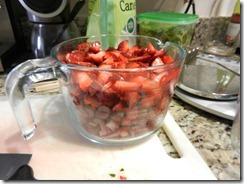
- Prepare custard pie filling by mixing:
- 1 c. sugar
- 2 eggs
- 2 ½ Tablespoons Flour
- ½ cup whipping cream
- Fold in fruit; pour into crust. Bake for 1 hour at 350ºF or until rhubarb is tender. Allow to cool to room temperature before serving.
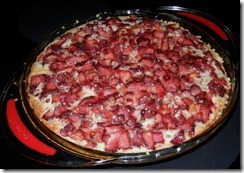
I don't know if the crust will hold together, but I didn't want to use a regular bread crust. Hope it works :)
Edit: The crust only sort of works. The first piece came out in crumbles; subsequent pieces I was able to get out in what would count for slices. The center soaked up some of the custard filling and made it less crusty and more gooey. Next time I'll try adding some egg, maybe some shredded coconut, making it thicker, brushing with egg white and/or pre-baking the crust longer. The good news is that the crust is delicious.
Clarified Butter
- Start with good butter. This is summer butter (made from milk when the cows are out to pasture, which means it's higher in Omega 3s) from a local creamery in Wisconsin.
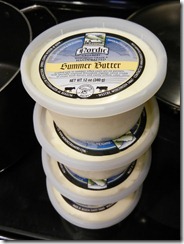
- Melt it.
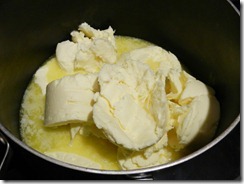
- Simmer it over medium to medium-low heat. Keep simmering.

- Eventually the milk solids clump together (the chunks on the bottom). Skim off and discard the foam on top. The butterfat (the clear golden liquid) is what you want. Pour it through a fine strainer and store.

- Done!
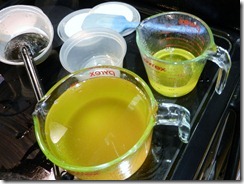
Sunday, June 5, 2011
Kefir Custard Fruit Tart
Strawberries and blueberries are in season, so it's time to put them to good use. Here's a recipe I whipped up using my favorite fermented treat, kefir. If you're not familiar with kefir, check out my other site: www.kefirpedia.org. Kefir's natural tart flavor goes great with fresh, sweet fruit!
- Preheat oven to 350ºF
- Prepare 2 cups of your favorite fruit (I'm using 1 cup of each quartered strawberries and whole blueberries)
- Prepare a crust in a pie pan. I'm using fillo dough since I had some in my freezer.
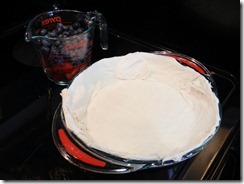
- In a large mixing bowl, combine and whisk together
- Place fruit in crust
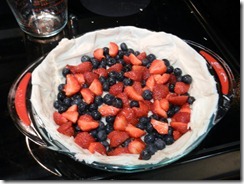
- Pour kefir mixture through a strainer (to remove any egg or kefir chunks) over the fruit.
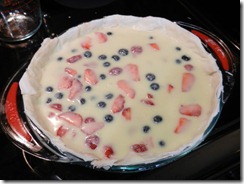
- Bake for 45 minutes, or until center of pie is at least 170ºF
- Let cool, then refrigerate.
The custard only sort of set. I think there's room to improve that part of this recipe – either cook it hotter/longer, cook it in a typical custard hot water bath, maybe pre-cook the fruit to get some moisture out, or filter the kefir whey out and make it with just the cream.
That said, if you make sure this is fully refrigerated before cutting into it, it will mostly hold its form. Enjoy!
Waste Not - Carrot Green Tabbouleh
Have you ever tried carrot greens? They taste quite a bit like parsley. So I set out to make this classic parsley salad using carrot greens instead. I'd rather not waste a perfectly good leafy green vegetable! Oh and I left out the classic ingredient bulgur wheat.
- Mince carrot greens until you get about 2 cups
- Mince mint to get about a 1/2 cup
- Press a clove of garlic into the green mix
- Add other veggies. This salad can take pretty much anything. I used a little of everything I had on hand:
- 1 rib of celery
- 2 raddishes
- 2 small carrots
- 1 green onion
- 1/2 medium onion, minced
- 6 quartered cherry tomatoes
- Add 1/2 cup lemon juice
- Add 1/8 to 1/4 cup olive oil
- Add 1t to 1T salt
Combine. Refrigerate to let flavors meld. Delicious, full of bright and fresh flavors.
Saturday, June 4, 2011
Grilled Chicken
Sprinkled with salt and generously doused in tandoori spices; butterflied; grilled for about 65 min, breast-up the whole time.
Scrambled Eggs
Gordon Ramsey teaches technique. http://youtu.be/dU_B3QNu_Ks
From the left, smoked gouda, top left corner some brewing kombucha (not relevant for this discussion), a jar of clarified butter; in the pan, green pepper & onions, cherry tomatoes roasting whole, and cube of smoked/cured ham.
For the egg technique, if you don't want to watch the video: crack four eggs into a cold pan, and add 1T of (clarified) butter. Add heat, stirring constantly. When they start to set, remove from heat and keep stirring. Add a little more heat...remove...about three or four times...keep stirring. Creates a great texture in the egg. Once cooked, add in your mixings. Gordon Ramsey adds crème fraîche at the end to stop the cooking, but I don't have any.
Tuesday, May 24, 2011
Simple Ingredients Make Great Meals
Grilled lamb rack chops, spinach sautéed in bacon fat & finished with garlic, grilled bell pepper; raw radishes, tomatoes and a glass of wine. Not pictured: two more chops (20oz total pre-cooked). Awesome meal, took under 20 minutes start to finish.
Friday, May 20, 2011
Sunday, May 15, 2011
Grilled Chicken
shallot, cilantro and curry puree. Side of grilled asparagus not
pictured.
Wednesday, May 4, 2011
Pork chops!
Grilled pork chops; mushrooms sautéed in bacon fat & olive oil; green beans sautéed in bacon fat, tossed in balsamic vinegar, topped with roasted almonds and bleu cheese.
Monday, May 2, 2011
Frittata
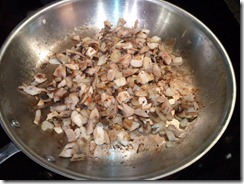 I had some leftover chicken, and so made a frittata. Sautee onions and mushrooms with chopped chicken. Once nearly done, add cooked broccoli (microwaved from frozen, in this case). Pour three beaten eggs over; tilt pan to distribute. Top still-wet eggs with shredded cheese (raw goat milk cheddar here) and place under a preheated broiler. Watch closely! Cook until cheese bubbles or browns. A clove of garlic would have been a wonderful addition, but I was out.
I had some leftover chicken, and so made a frittata. Sautee onions and mushrooms with chopped chicken. Once nearly done, add cooked broccoli (microwaved from frozen, in this case). Pour three beaten eggs over; tilt pan to distribute. Top still-wet eggs with shredded cheese (raw goat milk cheddar here) and place under a preheated broiler. Watch closely! Cook until cheese bubbles or browns. A clove of garlic would have been a wonderful addition, but I was out.

